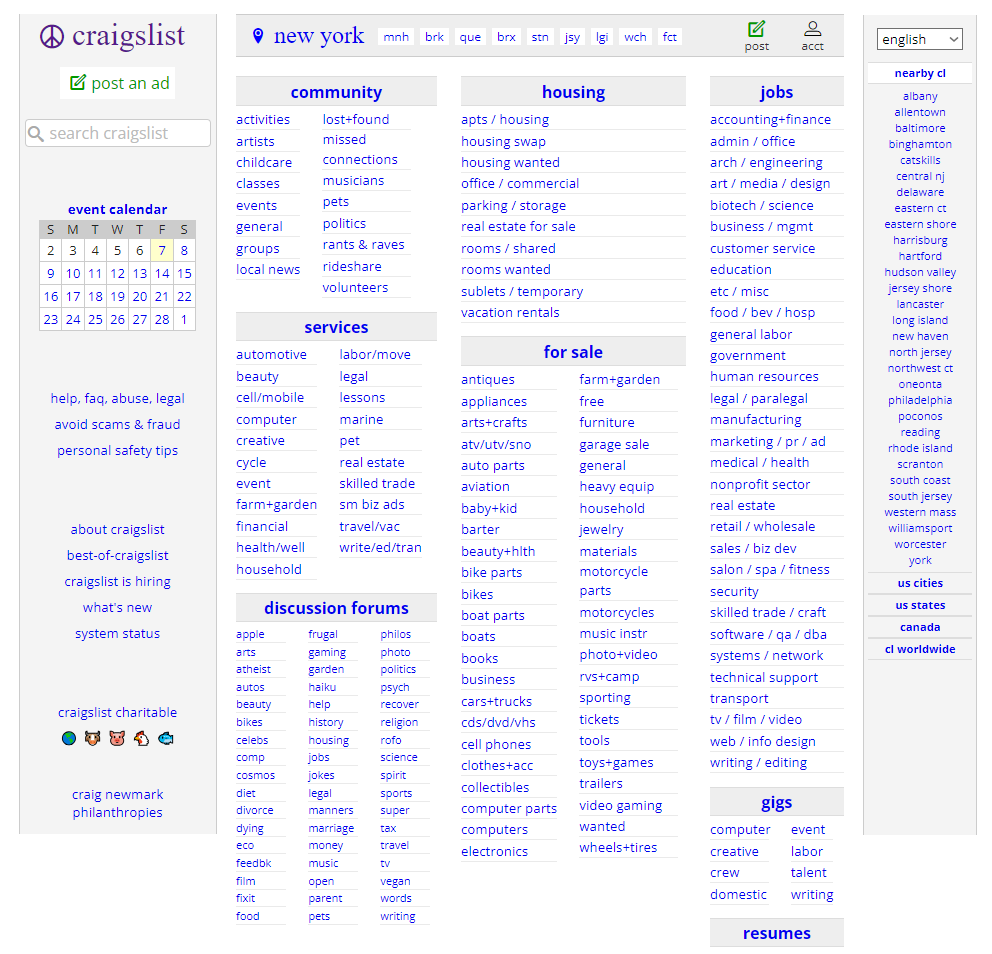Craigslist and The Shift from Generalist Platforms to Specific Solutions: A Digital Evolution
From Craigslist's Vertical Strategy to Specialized Services and What the Future Holds for the Digital Market

The 1990s were marked by intense economic and technological transformations, with the internet emerging as a global phenomenon that would deeply alter markets and the way people interacted with information. The popularization of the internet was driven by the increased access to personal computers, the rise of browsers (such as Netscape), and the expansion of broadband connections. By 1995, around 16 million people were using the internet, representing only 0.4% of the global population, but generating an innovation wave that continues to this day.
While the tired and repeated term "the advent of the internet" was still used with enthusiasm in any innovation talk, the world was undergoing a significant economic transition. It was the rise of the digital economy and the beginning of the "dot-com" bubble, fueled by high expectations in the American financial market (Ofer & Sato, 2011).
It was during this time of change that a "do-it-yourself" movement started to take off in the digital world. Low-cost, decentralized platforms began attracting users looking for alternatives to traditional methods like newspapers, magazines, and job agencies. In this environment, Craig Newmark launched Craigslist, changing the way people posted and searched for classifieds online.
The Beginning
Launched in 1995, Craigslist was a pioneer by bringing together various services into a single platform, transforming the way people connected and interacted with online classifieds. Craigslist broke away from the traditional classifieds model by creating a centralized and intuitive solution where users could post, search, and access ads across different categories in one place.
In the 2000s, this straightforward approach found an expanding audience, looking for more direct and accessible alternatives. Craigslist became indispensable in several regions around the world, allowing millions of users to interact independently and efficiently.
Business Model
Craigslist's business model stood out for its minimalism, in contrast to competitors that prioritized quick profits through aggressive advertising, expensive subscriptions, flashy animations, and pop-ups. Going against the market, Craigslist opted for a practical, distraction-free approach. This simplicity was also reflected in the user costs: most categories were free or offered at very low prices (such as "jobs" and "real estate" in specific regions), which helped democratize access to the platform.
Its low-cost operation also brought more sustainability, without large investments in marketing, generating higher profits. Allowing users to create, edit, and post ads themselves eliminated the need for traditional intermediaries (such as newspapers and employment agencies), creating a deep impact across various industries. In the journalism sector, for example, the mass migration of classified ads to the online space drastically reduced the revenue of local publications, especially in categories like real estate and jobs. According to the Pew Research Center (2010), Craigslist contributed to a 70% drop in local newspaper classified ad revenue in the U.S. between 2000 and 2009. For the classified advertising sector, Craigslist saved advertisers $5 billion from 2000 to 2007, according to an analysis by Robert Seamans of New York University and Feng Zhu of Harvard Business School.
Craigslist's global expansion was another strategic pillar: although it started in the United States, the platform quickly reached other international markets with a replicable and low-cost business model. The lack of major investments in marketing or cultural adaptations allowed for agile and efficient expansion. Its universal simplicity was enough to attract users in different countries without the need for complex customizations.
Additionally, Craigslist wasn't just a classified ads platform; it was also a community connection tool. It offered space for local events, community services, and even discussions, creating a network of interactions beyond buying and selling. This focus on community helped establish a loyal user base, who saw Craigslist as more than just a marketplace.
This commitment to community was one of the main factors behind the platform's longevity. While many competitors focused blindly on revenue and failed to maintain user engagement, Craigslist managed to sustain its relevance through an organic approach centered on the real needs of its users.
The Decline
The disruptive and verticalized model used by Craigslist proved especially effective during the 90s and 2000s, at a time when the internet was expanding and still largely unexplored for this type of service. However, with the growth of the internet and the emergence of new companies, Craigslist began facing increasingly fierce competition. What was initially its main advantage — centralizing multiple business sectors into a single platform — eventually became a challenge. Specialized startups began offering more personalized and optimized experiences, focusing on serving specific niches, which gradually attracted users seeking more modern solutions tailored to their needs.
The unbundling
The term "Unbundling" refers to the process of breaking down an all-in-one platform or service into individual, specialized solutions. The term was popularized by Ben Thompson, who used the concept to describe how companies deconstruct monolithic services into niche products.
This shift from a verticalized model to a horizontal model was driven by several changes in market demands and technological innovations that occurred throughout the 2000s. Instead of covering all sectors at once, new startups targeting specific niches began creating platforms dedicated to a single service or type of product, but with more user-friendly interfaces and specialized features.
eBay, for example, specialized in auctions and product sales, offering a robust and efficient platform for online buying and selling. Standing out for its intuitive interface, integrated payment systems, and a business model that allowed transactions to be carried out in a more reliable and secure manner, it attracted both consumers and sellers.
LinkedIn changed the game in online recruitment by focusing exclusively on the professional market, creating a social network dedicated to networking and job searching. This specialization allowed LinkedIn to become the leading platform for professionals, something that Craigslist, with its portfolio of diverse services, was unable to achieve in the same way.
Another platform that emerged and captured a significant share of the job market was Indeed, founded in 2004. A job search engine that compiles listings from thousands of websites, including companies, recruitment agencies, and other specialized services. What sets Indeed apart from Craigslist is its highly efficient search functionality, with detailed filters for location, job type, salary range, and many other criteria, in addition to allowing candidates to upload their resumes, apply directly to job postings, and receive personalized alerts.
These platforms not only optimized the recruitment process but also began offering payment solutions for recruiters, such as paid ads and targeted candidate recruitment, creating a more robust and efficient experience than Craigslist could provide.
Focused exclusively on the real estate market, offering a more robust platform for buying, selling, and renting properties, Zillow's specialization and enhanced user experience made it the leader in the real estate sector, overshadowing the generic property listings on Craigslist.
Airbnb, launched in 2008, transformed the accommodation market by creating a platform that allowed ordinary people to rent out rooms or entire properties to guests in a simple, transparent, and secure way. Airbnb not only simplified the process of booking short-term rentals but also added layers of security, such as user and host reviews, payment protection, and an identity verification system. Unlike Craigslist, which had little control over the listings, Airbnb ensured a higher level of trust, which was crucial for its global expansion.
The shift towards more horizontal solutions had a deep impact on the digital market. The specialization of these startups enabled a more effective monetization model. On a broader scale, Craigslist's verticalized model, which was initially advantageous due to its simplicity and low cost, was gradually replaced by a more complex and segmented model, where small but highly specialized companies dominated specific sectors. This shift was a result of the maturation of the internet, its innovations, and changes in consumer expectations, who began demanding more agility, personalization, and specialization in online services.
The impact on the market was deep. Instead of a single platform dominating multiple sectors, the market began to fragment, with smaller companies focusing on specific niches, but offering much higher value to consumers and becoming more efficient in their operations. This led to increased competition, innovation, and specialization, which, in turn, further fueled the growth of the digital ecosystem.
In the end, what's the next step?
When we look at the transition from platforms like Craigslist to more specialized and horizontal solutions, we see a move forward in terms of personalization, user experience and efficiency. However, this fragmentation, while offering benefits, also brings new challenges. Who doesn’t feel overwhelmed by the number of apps and isolated services we use? The credit card bill is a reminder: how many streaming services are we subscribed to now? I always catch myself thinking about the time when we signed up for cable TV and had to pick and subscribe to each channel individually—remember that? Today, we’re doing the same with multiple streaming services. And that brings up the question: are we reaching a point where the digital market will enter a new phase of recentralization?
Decentralization seems to have reached a limit, especially when we realize that users are starting to seek more simplicity and integration. In this context, SuperApps are emerging, dominating markets like China’s, and starting to gain ground in the West—something I plan to dive into in another article.
The success of this trend will depend on how platforms handle issues like privacy, consumer trust, and regulation. It could be that the next big digital wave will be integration. Whoever can navigate and master this new space has a great chance of shaping how we interact online in the coming decades.
References
ADP Research Institute. (2006). National Employment Report: The rise of online recruitment platforms;
Chevalier, J. A., & Goolsbee, A. (2013). Measuring prices and price competition online: A case study of Craigslist and real estate. Management Science, 59(3), 611–626;
Economides, N., & Himmelberg, C. (1995). The effect of content on global Internet adoption and the global digital divide. Stern School of Business, New York University;
Forrester Research. (2007). The impact of Craigslist on local real estate markets;
Gautier, P. A., & Holzhey, M. (2014). Craigslist saved consumers a lot of money while crippling newspapers. Harvard Business Review;
Katz, J., Rice, R. E., & Aspden, P. (2001). The Internet, 1995-2000: Access, civic involvement, and social interaction. arXiv. Cornell University;
Ofer, A., & Sato, K. (2011). A short note on the size of the dot-com bubble (Working Paper No. 12011). National Bureau of Economic Research;
Pew Research Center. (1995, October 16). Americans going online: Explosive growth, uncertain destinations. Pew Research Center;
Pew Research Center. (2010). How Craigslist impacted classified advertising;
Pew Research Center. (2014, February 27). The web at 25 in the U.S. Pew Research Center;
The Economist. (2008). How Craigslist is killing local newspapers. The Economist;
Thompson, B. (n.d.). Bundling and Unbundling. Stratechery.










